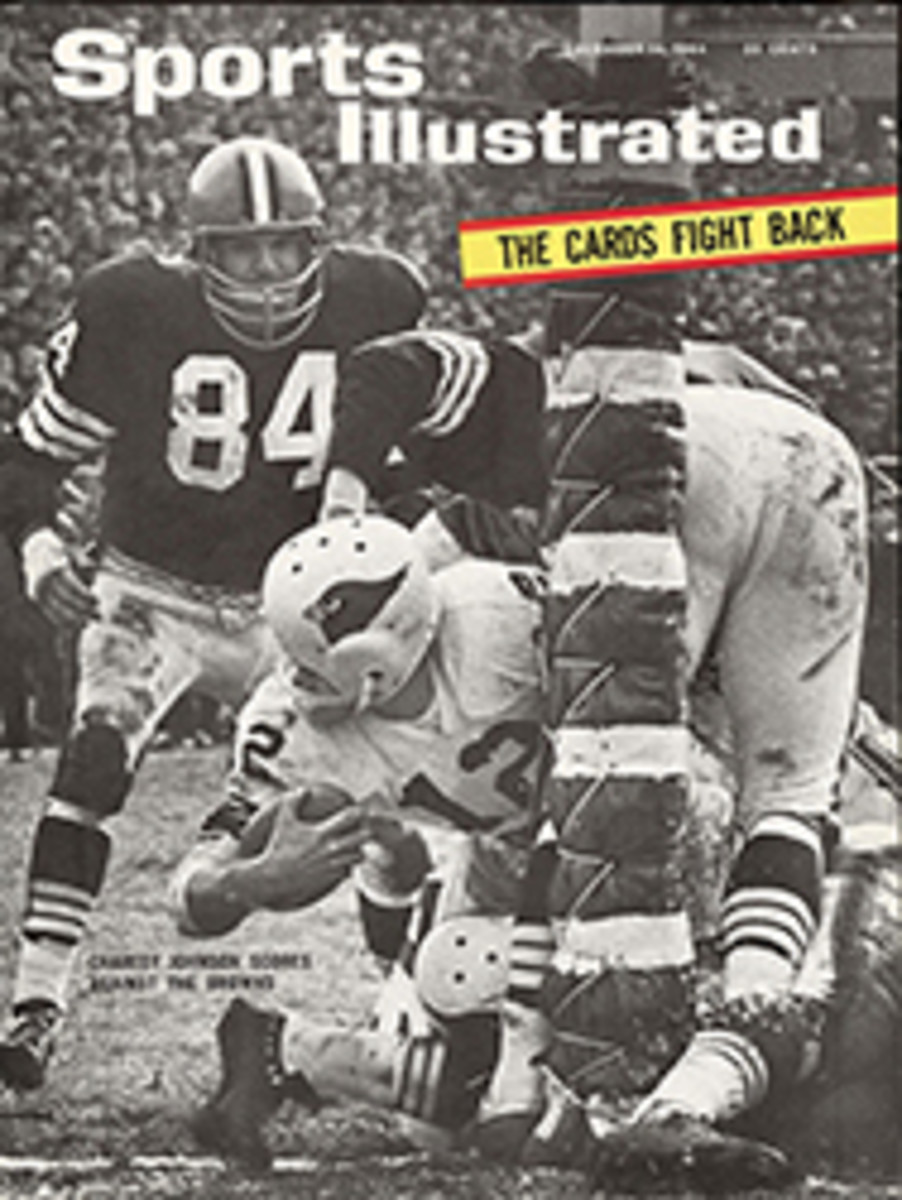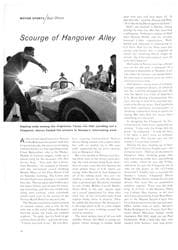
The fastest human in spikes—or cleats
Activity is to be avoided at all costs during the hot, humid dog days around Jacksonville in northern Florida. But on the Florida A&M campus, at precisely the time the air hangs heaviest, the cry of "On the hop!" sends a squadron of football players in full equipment sprinting up a nearly vertical incline known as Horror Hill. The dash is famous. It is an all-out, dust-raising, hold-on-to-your-hat charge negotiated with the kind of speed found nowhere this side of the Olympic 100-meter dash. It is not surprising, therefore, that during the past three years the first man to crest Horror Hill always has been Left Halfback Robert Lee Hayes, the same Bob Hayes who won two gold medals in Tokyo and is this year's version of the world's fastest human.
Last week, his Olympic medals and records behind him, Hayes was back doing what he likes best: playing football. The fact that Hayes can run faster than anyone else has made him the object of professional football interest. Hayes was drafted last year by Dallas of the NFL and Denver of the AFL, and Saturday representatives from these teams set speed records of their own rushing from the press box to the dressing room at the end of the Orange Blossom Classic in Miami's Orange Bowl. The fact that Florida A&M defeated Grambling 42-15 was of only mild interest. Hayes's catch of a 30-yard pass and 20-yard run for a touchdown, plus two slashing runs for two-point conversions, were more to the point.
But, for all his accomplishments, the question persists: Is Robert Hayes, track star, going to make good as a pro player? He will not be the first Olympic medalist to give professional football a try. Except for Quarter-miler Ollie Matson, the form charts have been dismal. Most of Hayes's predecessors found that on the gridiron the shortest distance between two points invariably was blocked by a 260-pound tackle. And, invariably, that finished them.
"Bob Hayes is not one of these," insists his coach, Jake Gaither, a graying man whose cry of "On the hop!" has sent such players as Willie Galimore and Clarence Childs up Horror Hill and into pro ball. Whenever he endorses a player there is a ring of authority to what he says. "Hayes is a football player first," he says, "and a track star second." Physically, Hayes confirms the judgment. Observers have always had the impression that the 194-pound sprinter with the deep, powerful chest, thick thighs and rolling gait was absurdly out of place in track briefs. It was not until the players took up wind sprints that Line Coach Robert Griffin, who happens also to be the track coach, began to suspect that A&M had something more than a good young halfback.
Gaither, of course, was convinced he had a football player. "Hayes has more going for him than Galimore had," he said last week, and that is high praise indeed. Before he was killed in an auto accident last summer, the Chicago Bear back was considered one of the best runners in the NFL. But Gaither insists Hayes is a better open-field runner, a better pass catcher, and he obviously is faster. "He can't cut like Willie could," says Gaither, "but, then, neither could anyone else."
At this point Gaither is just getting warmed up. "Hayes can punt 60 yards," he says, "and can kick off over the goal line. I haven't let him because I didn't want someone to hit him with his leg in the air." Gaither was criticized for letting Hayes play football at all, but says, "Shucks, if he had to choose one or the other he'd have chucked his track shoes out the window." As it was, the entire Florida A&M coaching staff had to be on guard lest Hayes sneak into a game when the situation called for brawn rather than speed. The brutal sting of direct contact is his idea of a really good time. One gets the impression that Hayes is more than a little disappointed that he was not drafted as a tackle.
For those who remain the least bit skeptical, Gaither has another trump card—his collection of game films, such as the one against Texas Southern two weeks ago. In the first half it showed Hayes being jostled by defensive backs and still catching passes. One was worth 19 yards and a touchdown, and the other went for 43 yards and another touchdown. "You ain't seen anything yet," said Gaither, rubbing his hands together. Next scene opened with Hayes lined up close behind the line in a halfback position instead of wide in his usual flanker-back spot. The quarterback pitched out to him, and Hayes turned the end, following his blockers in a way rarely learned by converted sprinters. An instant later two defenders had Hayes cornered against the sideline. He slowed, skipped left, then right and, when one of the defenders fell down, turned on what Gaither calls his "scat gear." He raced straight out of the picture. The camera next caught him prancing in the end zone, 58 yards away.
"We think he's a great football prospect," says Dallas Cowboy General Manager Tex Schramm. "He's different from other track men who have attempted to play football, in that he has the natural moves and instincts of a football player. He has very, very good hands—he catches the ball surely and with ease. He has soft hands. And he is very good at catching punts and kickoffs.
"He could be a flanker, a running back or even, potentially, a defensive back. His only weakness that we know of is his inexperience, and with his tremendous natural abilities that shouldn't be a handicap for very long."
Hayes agrees with this. "Oh, I know I've got an awful lot to learn," he says, "but I love this game. I don't have to learn what it feels like to get hit. I know the importance of following my blockers. Maybe I don't know the fakes now, but I sure know you gotta have them, and that's more than most pure sprinters know. I've studied all the good flankers, and I think I can catch a ball with any of them, and I'm faster." This is not conceit. It is Hayes's matter-of-fact way of reciting the obvious.
For all Bob Hayes's individual skills, Florida A&M went into the game with Louisiana's Grambling as one-touchdown underdogs, a fact very puzzling to Jake Gaither. No less than 16 of his backs have been timed in the 100-yard dash at under 10 seconds, including six freshmen who are just a hot breath behind Hayes himself. And instead of the traditionally smallish lines that Gaither assembles, this year's averages 235 pounds and is quick. And three players besides Hayes were drafted by the pros. Halfback Bobby Felts was picked by Baltimore and Houston, junior Dave Daniels, a 6-foot-4, 220-pound tackle, was chosen as a Bear future pick, and both Minnesota and Houston are bidding for a 6-foot-3 255-pounder named Carlton Oaks, who plays end. "This team should be the best I've ever had," says Gaither, "but it isn't." A&M lost a regular-season game, and this is something it usually does only in the Orange Blossom, a unique bowl game in which A&M is always host and the other top Negro school in the country is the guest. It is nice to know that, no matter what happens, you are going to a bowl, but this also creates certain pressures. As Gaither says, "It means we can't have a bad year." Since 1945 Gaither's teams, which have won 165 games against only 25 losses, have not.
In this year's Orange Blossom, Grambling did not have the hair-raising speed of Florida, but its backs were quick enough and the line, with an average weight of 240 pounds a man, was the biggest in college football. And Grambling could match its host draft pick for draft pick. Quarterback Mike Howell was selected by the Browns and Chargers, and Flanker Willie Williams was chosen by the Giants. It is, however, the Grambling tackles who are particularly awesome. Frank Kornish (Chicago and Kansas City) weighs in at 270, and Alfonse Dotson (Green Bay and Kansas City) is 10 pounds lighter but 10 pounds meaner. When told that Florida A&M was going to test them (it is Gaither's contention that nobody stops his slants off tackle), Dotson lifted one eyebrow and murmured: "You don't say so?"
Gaither reverted to prayer—of a sort—just before kickoff. The players gathered and said in unison: "We wounded them. They have fallen at our feet. They shall not rise. Allah." Gaither has no idea what the incantation means, but he has been using it since his first game, and he has no plans for breaking the habit now. Prayers weren't needed. A&M simply was too fast for Grambling—and in the first half it was using Hayes only as a decoy. He never carried the ball from scrimmage, and he was not passed to once. People in the Orange Bowl were beginning to wonder just what Hayes was supposed to be doing out there.
They got the answer in the third quarter. Quarterback Ernie Hart went back to pass, and a single, somewhat bored Grambling secondary defender ambled over to cover Hayes. The desultory young man might just as well have laid his head in a lion's mouth and fallen asleep. Suddenly Hayes was not just running through another pass pattern. He was sprinting, and he was in the clear. When he caught the pass on the 20, two other defenders raced over, but Hayes was in top gear by then, and with that strange, rocking stride of his left the two men staring at each other.
The pros came running almost as fast as Hayes, and Dallas, with a little more money, was ahead from the start.
PHOTO
ELUDING TACKLER AFTER PITCHOUT, HAYES, A SHIFTY—AS WELL AS SWIFT—RUNNING BACK, LEAPS INTO AIR TO RIP LEFT LEG FREE

